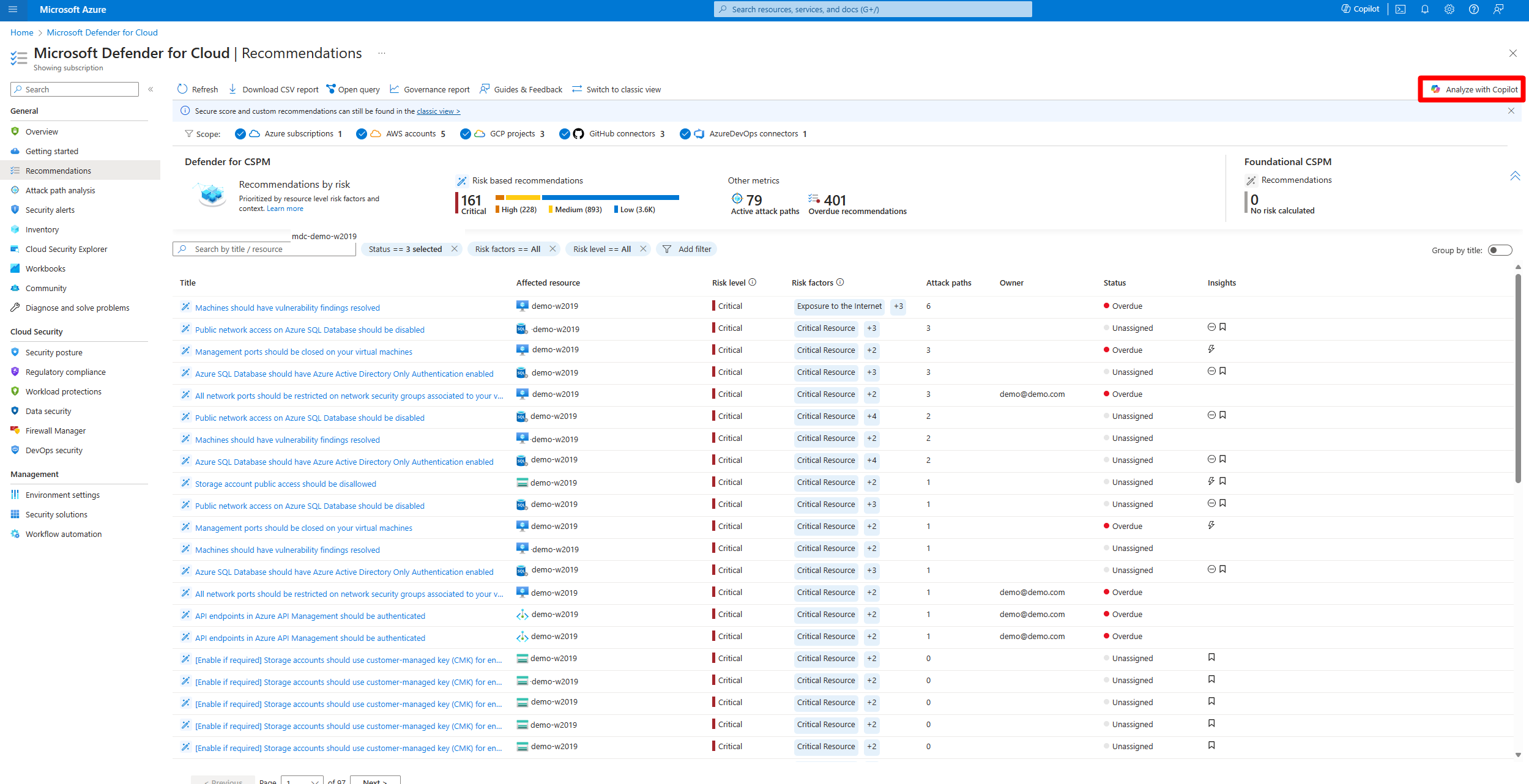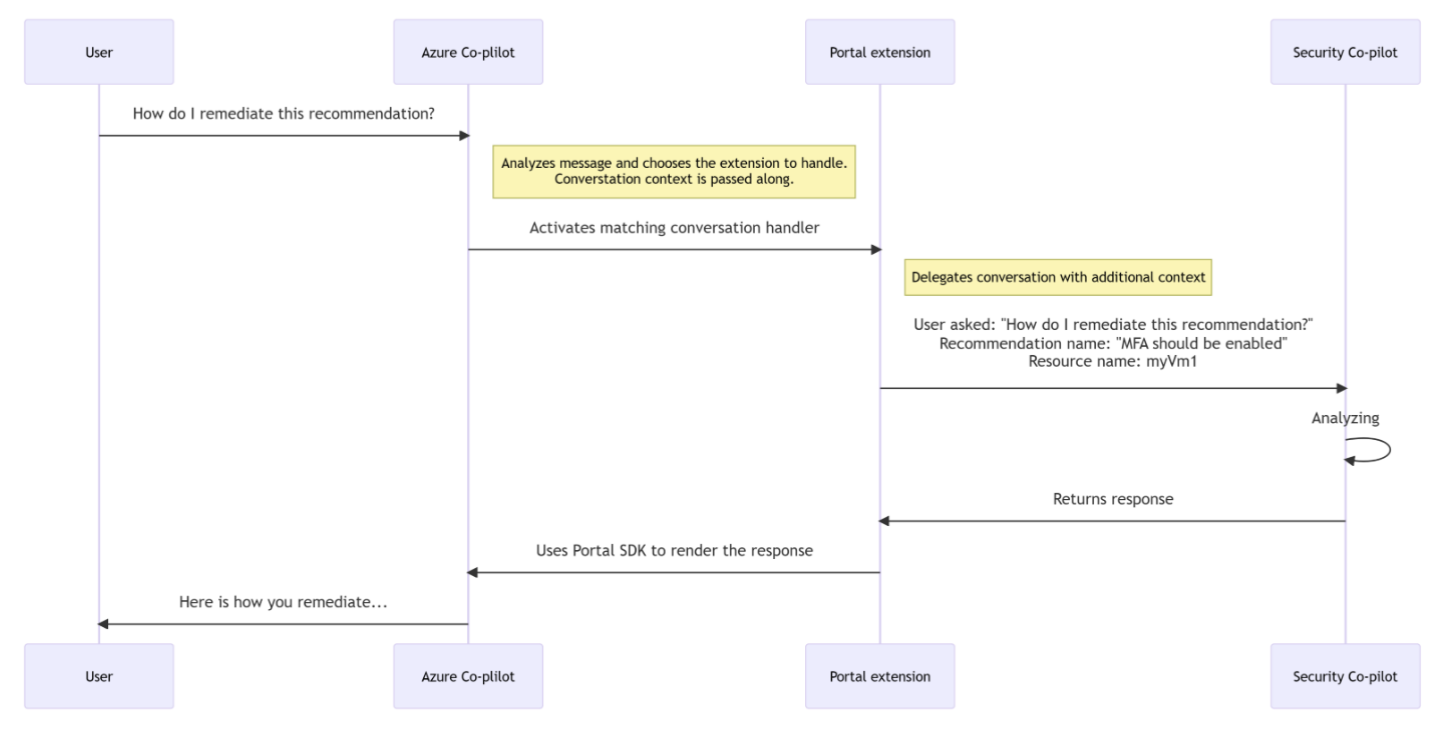Microsoft Security Copilot in Defender for Cloud (Preview)
Microsoft Defender for Cloud integrates both Microsoft Security Copilot and Microsoft Copilot for Azure into its experience. With these integrations, you can ask security-related questions, receive responses, and automatically trigger the necessary skills needed to analyze, summarize, remediate, and delegate recommendations using natural language prompts.
Both Security Copilot and Copilot for Azure are cloud-based AI platforms that provide a natural language copilot experience. They assist security professionals in understanding the context and effect of recommendations, remediating or delegating tasks, and addressing misconfigurations in code.
Defender for Cloud's integration with Security Copilot and Copilot for Azure on the recommendations page allows you to enhance your security posture and mitigate risks in your environments. This integration streamlines the process of understanding and implementing recommendations, making your security management more efficient and effective.
Learn more about Security Copilot
If you're new to Security Copilot, you should familiarize yourself with it by reading these articles:
- What is Microsoft Security Copilot?
- Microsoft Security Copilot experiences
- Get started with Microsoft Security Copilot
- Understand authentication in Microsoft Security Copilot
- Prompting in Microsoft Security Copilot
Security Copilot integration in Defender for Cloud
Defender for Cloud integrates Copilot directly into the Defender for Cloud experience. This integration allows you to analyze, summarize, remediate, and delegate your recommendations with natural language prompts.
When you open Copilot, you can use natural language prompts to ask questions about the recommendations. Copilot provides responses in natural language, helping you understand the context of the recommendation. It also explains the effect of implementing the recommendation and provides steps for implementation.
Some sample prompts include:
- Show critical risks for publicly exposed resources
- Show critical risks to sensitive data
- Show resources with high severity vulnerabilities
Copilot can assist with refining recommendations, providing summaries, remediation steps, and delegation. It enhances your ability to analyze and act on recommendations.
Key features
The following section provides information about the available feature in Security Copilot in Microsoft Defender for Cloud.
Data processing workflow
When you use Security Copilot in Defender for Cloud, the following data processing workflow occurs:
A user enters a prompt in the Copilot interface.
Copilot for Azure receives the prompt.
Copilot for Azure evaluates the prompt and the active page, to determine the skills needed to resolve the prompt.
If the prompt is security related and the skill is available, Security Copilot executes the skills and sends back a response to Copilot in Azure for presentation.
If a security-related prompt is received but the skill is unavailable, Azure Copilot searches all of its available skills to find the most relevant skills to resolve the prompt. A response is then sent to the user.
Check out the Security Copilot FAQs.
Enable the Security Copilot integration in Defender for Cloud
Security Copilot in Defender for Cloud isn't reliant on any of the available plans in Defender for Cloud. Security Copilot is available for all users when you:
- Enable Defender for Cloud on your environment.
- Have access to Azure Copilot.
- Have Security Compute Units assigned for Security Copilot.
However, in order to enjoy the full range of Security Copilot's capabilities in Defender for Cloud, we recommend enabling the Defender for Cloud Security Posture Management (DCSPM) plan on your environments. The DCSPM plan includes many extra security features such as Attack path analysis, Risk prioritization and more, all of which can be navigated and managed using Security Copilot. Without the DCSPM plan, you're still able to use Security Copilot in Defender for Cloud, but in a limited capacity.
Monitor your usage
Security Copilot has a usage limit. When the usage in your organization is nearing its limit, you're notified when you submit a prompt. To avoid a disruption of service, contact the Azure capacity owner or contributor to increase the Security Compute Units (SCU) or limit the number of prompts.
Learn more about usage limits.
Provide feedback
Your feedback on the Defender for Cloud integration with Security Copilot helps with development. To provide feedback, in Copilot, select How's this response? At the bottom of each completed prompt and select any of the following options:
- Looks right - Select this button if the results are accurate, based on your assessment.
- Needs improvement - Select this button if any detail in the results is incorrect or incomplete, based on your assessment.
- Inappropriate - Select this button if the results contain questionable, ambiguous, or potentially harmful information.
For each feedback button, you can provide more information in the next dialog box that appears. Whenever possible, and when the result is Needs improvement, write a few words explaining what can be done to improve the outcome. If you entered prompts specific to Defender for Cloud and the results aren't related, include that information.
Privacy and data security in Security Copilot
When you interact with Security Copilot to get Defender TI data, Copilot pulls that data from Defender for Cloud. The prompts, the data retrieved, and the output shown in the prompt results are processed and stored within the Copilot service. Learn more about privacy and data security in Microsoft Security Copilot


